engine coolant KIA Soul 2013 1.G Owner's Manual
[x] Cancel search | Manufacturer: KIA, Model Year: 2013, Model line: Soul, Model: KIA Soul 2013 1.GPages: 393, PDF Size: 8.76 MB
Page 6 of 393
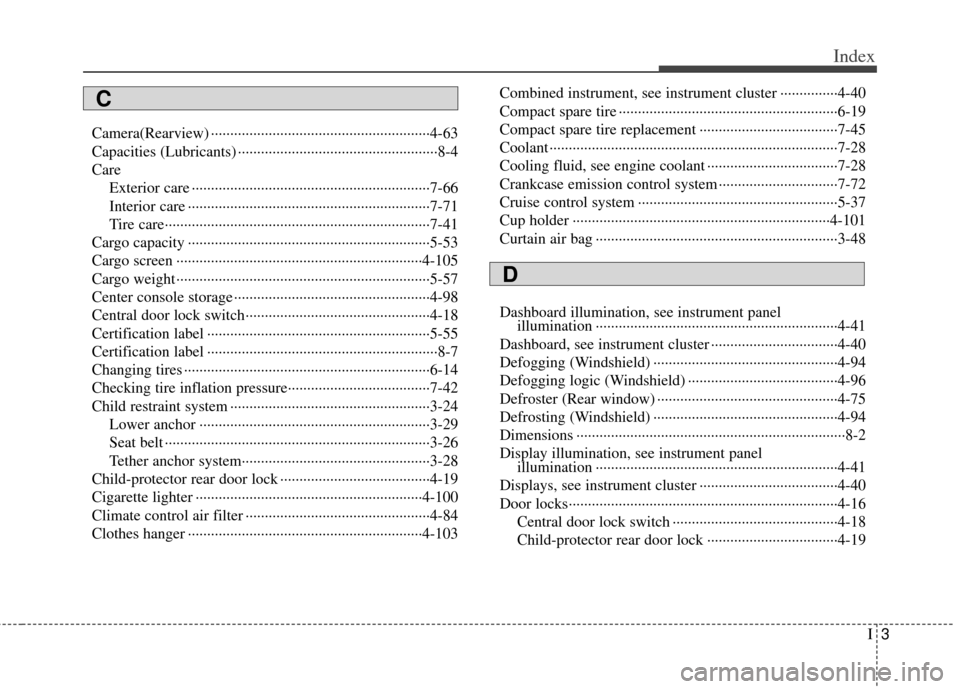
I3
Index
Camera(Rearview) ··················\
··················\
··················\
···4-63
Capacities (Lubricants) ··················\
··················\
················8-4
CareExterior care ··················\
··················\
··················\
········7-66
Interior care ··················\
··················\
··················\
·········7-71
Tire care··················\
··················\
··················\
···············7-41
Cargo capacity ··················\
··················\
··················\
·········5-53
Cargo screen ··················\
··················\
··················\
··········4-105
Cargo weight ··················\
··················\
··················\
············5-57
Center console storage ··················\
··················\
···············4-98
Central door lock switch··················\
··················\
············4-18
Certification label ··················\
··················\
··················\
····5-55
Certification label ··················\
··················\
··················\
······8-7
Changing tires ··················\
··················\
··················\
··········6-14
Checking tire inflation pressure··················\
··················\
·7-42
Child restraint system ··················\
··················\
················3-24 Lower anchor ··················\
··················\
··················\
······3-29
Seat belt ··················\
··················\
··················\
···············3-26
Tether anchor system··················\
··················\
·············3-28
Child-protector rear door lock ··················\
··················\
···4-19
Cigarette lighter ··················\
··················\
··················\
·····4-100
Climate control air filter ··················\
··················\
············4-84
Clothes hanger ··················\
··················\
··················\
·······4-103 Combined instrument, see instrument cluster ···············4-40
Compact spare tire ··················\
··················\
··················\
···6-19
Compact spare tire replacement ··················\
··················\
7-45
Coolant ··················\
··················\
··················\
··················\
···7-28
Cooling fluid, see engine coolant ··················\
················7-28
Crankcase emission control system ··················\
·············7-72
Cruise control system ··················\
··················\
················5-37
Cup holder ··················\
··················\
··················\
·············4-101
Curtain air bag ··················\
··················\
··················\
·········3-48
Dashboard illumination, see instrument panel
illumination ··················\
··················\
··················\
·········4-41
Dashboard, see instrument cluster ··················\
···············4-40
Defogging (Windshield) ··················\
··················\
············4-94
Defogging logic (Windshield) ··················\
··················\
···4-96
Defroster (Rear window) ··················\
··················\
···········4-75
Defrosting (Windshield) ··················\
··················\
············4-94
Dimensions ··················\
··················\
··················\
················8-2
Display illumination, see instrument panel illumination ··················\
··················\
··················\
·········4-41
Displays, see instrument cluster ··················\
··················\
4-40
Door locks··················\
··················\
··················\
················4-16 Central door lock switch ··················\
··················\
·······4-18
Child-protector rear door lock ··················\
················4-19
D
C
Page 7 of 393

Index
4I
Drinks holders, see cup holders··················\
·················4-10\
1
Driver's 3-point seat belt··················\
··················\
············3-15
Driver's and passenger's front air bag··················\
··········3-44
Driving at night··················\
··················\
··················\
········5-46
Driving in flooded areas ··················\
··················\
············5-47
Driving in the rain ··················\
··················\
··················\
···5-47
Economical operation ··················\
··················\
················5-42
Electric chromic mirror ··················\
··················\
·············4-36
Electric power steering ··················\
··················\
··············4-34
Electronic stability control(ESC)··················\
·················5-30\
Emergency starting ··················\
··················\
··················\
····6-4Jump starting ··················\
··················\
··················\
·········6-5
Push starting ··················\
··················\
··················\
··········6-6
Emergency while driving··················\
··················\
·············6-3
Emission control system ··················\
··················\
············7-72 Crankcase emission control system ··················\
········7-72
Evaporative emission control System ··················\
·····7-72
Exhaust emission control system ··················\
············7-73
Engine ··················\
··················\
··················\
··················\
······8-2
Engine compartment ··················\
··················\
··················\
··2-4
Engine coolant ··················\
··················\
··················\
·········7-28
Engine number ··················\
··················\
··················\
···········8-8
Engine oil ··················\
··················\
··················\
·················7-26\
Engine overheats··················\
··················\
··················\
········6-7
Engine start/stop button ··················\
··················\
···············5-8 Engine temperature gauge ··················\
··················\
·········4-42
Engine will not start··················\
··················\
··················\
···6-4
Evaporative emission control System ··················\
·········7-72
Exhaust emission control system··················\
·················7-73\
Explanation of scheduled maintenance items ···············7-22
Exterior care··················\
··················\
··················\
·············7-66
Exterior features··················\
··················\
··················\
·····4-107
Roof rack ··················\
··················\
··················\
···········4-107
Flat tire (with spare tire) ··················\
··················\
············6-13 Changing tires ··················\
··················\
··················\
·····6-14
Compact spare tire ··················\
··················\
················6-19
Removing and storing the spare tire ··················\
·······6-14
Floor mat anchor(s) ··················\
··················\
·················4-10\
4
Fluid Brakes/clutch fluid ··················\
··················\
················7-31
Washer fluid ··················\
··················\
··················\
········7-32
Folding the rear seat ··················\
··················\
··················\
3-10
Front passenger and rear seat belt ··················\
···············3-17
Front seat adjustment ··················\
··················\
··················\
·3-4
Fuel filler lid ··················\
··················\
··················\
············4-27
Fuel gauge··················\
··················\
··················\
················4-43
Fuel requirements ··················\
··················\
··················\
······1-3
E
F
Page 23 of 393
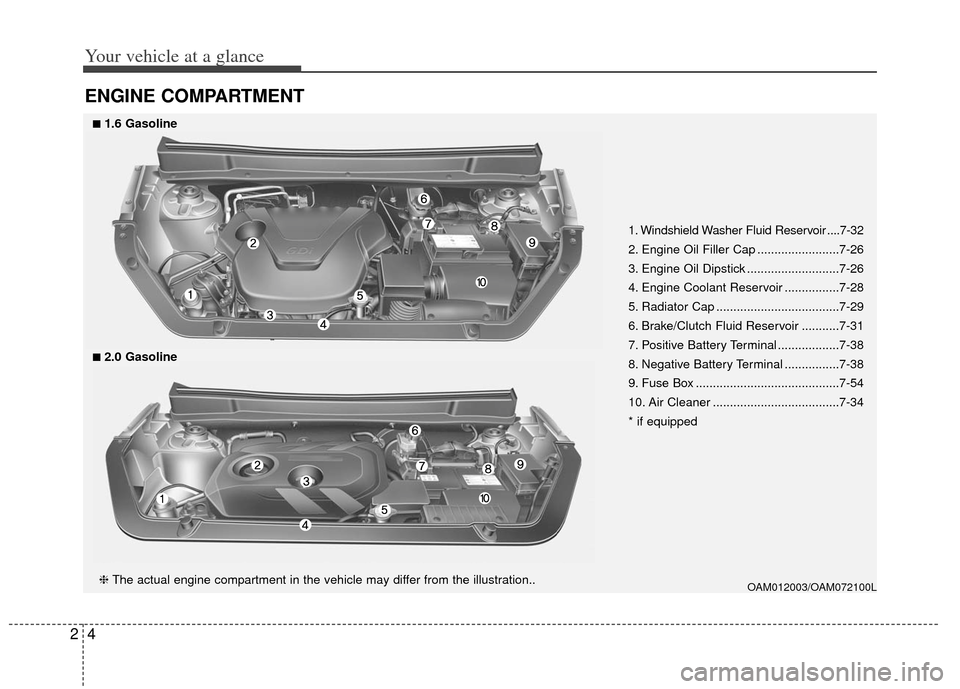
Your vehicle at a glance
42
ENGINE COMPARTMENT
OAM012003/OAM072100L
1. Windshield Washer Fluid Reservoir ....7-32
2. Engine Oil Filler Cap ........................7-26
3. Engine Oil Dipstick ...........................7-26
4. Engine Coolant Reservoir ................7-28
5. Radiator Cap ....................................7-29
6. Brake/Clutch Fluid Reservoir ...........7-31
7. Positive Battery Terminal ..................7-38
8. Negative Battery Terminal ................7-38
9. Fuse Box ..........................................7-54
10. Air Cleaner .....................................7-34
* if equipped
❈The actual engine compartment in the vehicle may differ from the illustration..
■2.0 Gasoline
■1.6 Gasoline
Page 121 of 393
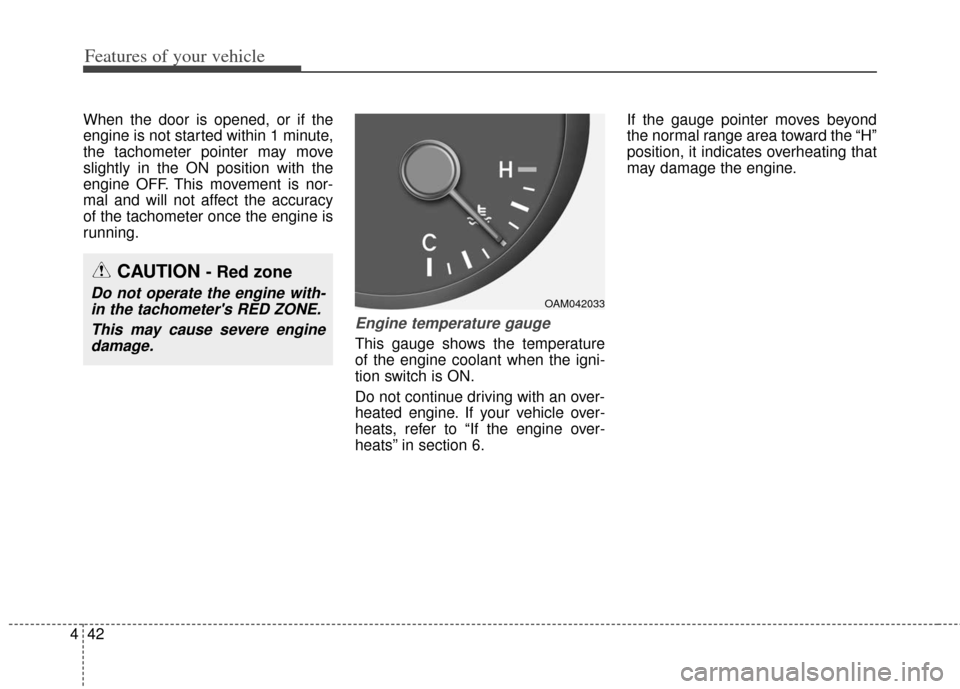
Features of your vehicle
42
4
When the door is opened, or if the
engine is not started within 1 minute,
the tachometer pointer may move
slightly in the ON position with the
engine OFF. This movement is nor-
mal and will not affect the accuracy
of the tachometer once the engine is
running.
Engine temperature gauge
This gauge shows the temperature
of the engine coolant when the igni-
tion switch is ON.
Do not continue driving with an over-
heated engine. If your vehicle over-
heats, refer to “If the engine over-
heats” in section 6. If the gauge pointer moves beyond
the normal range area toward the “H”
position, it indicates overheating that
may damage the engine.
OAM042033
CAUTION - Red zone
Do not operate the engine with-
in the tachometer's RED ZONE.
This may cause severe enginedamage.
Page 162 of 393
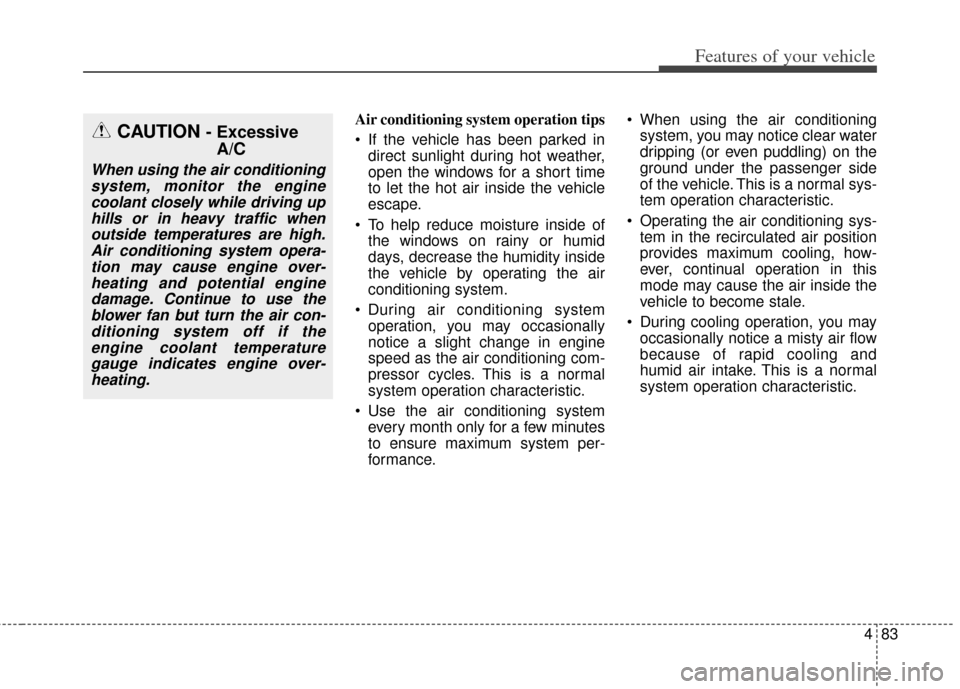
483
Features of your vehicle
Air conditioning system operation tips
If the vehicle has been parked indirect sunlight during hot weather,
open the windows for a short time
to let the hot air inside the vehicle
escape.
To help reduce moisture inside of the windows on rainy or humid
days, decrease the humidity inside
the vehicle by operating the air
conditioning system.
During air conditioning system operation, you may occasionally
notice a slight change in engine
speed as the air conditioning com-
pressor cycles. This is a normal
system operation characteristic.
Use the air conditioning system every month only for a few minutes
to ensure maximum system per-
formance. When using the air conditioning
system, you may notice clear water
dripping (or even puddling) on the
ground under the passenger side
of the vehicle. This is a normal sys-
tem operation characteristic.
Operating the air conditioning sys- tem in the recirculated air position
provides maximum cooling, how-
ever, continual operation in this
mode may cause the air inside the
vehicle to become stale.
During cooling operation, you may occasionally notice a misty air flow
because of rapid cooling and
humid air intake. This is a normal
system operation characteristic.CAUTION - ExcessiveA/C
When using the air conditioning
system, monitor the enginecoolant closely while driving uphills or in heavy traffic whenoutside temperatures are high.Air conditioning system opera-tion may cause engine over-heating and potential enginedamage. Continue to use theblower fan but turn the air con-ditioning system off if theengine coolant temperaturegauge indicates engine over-heating.
Page 225 of 393
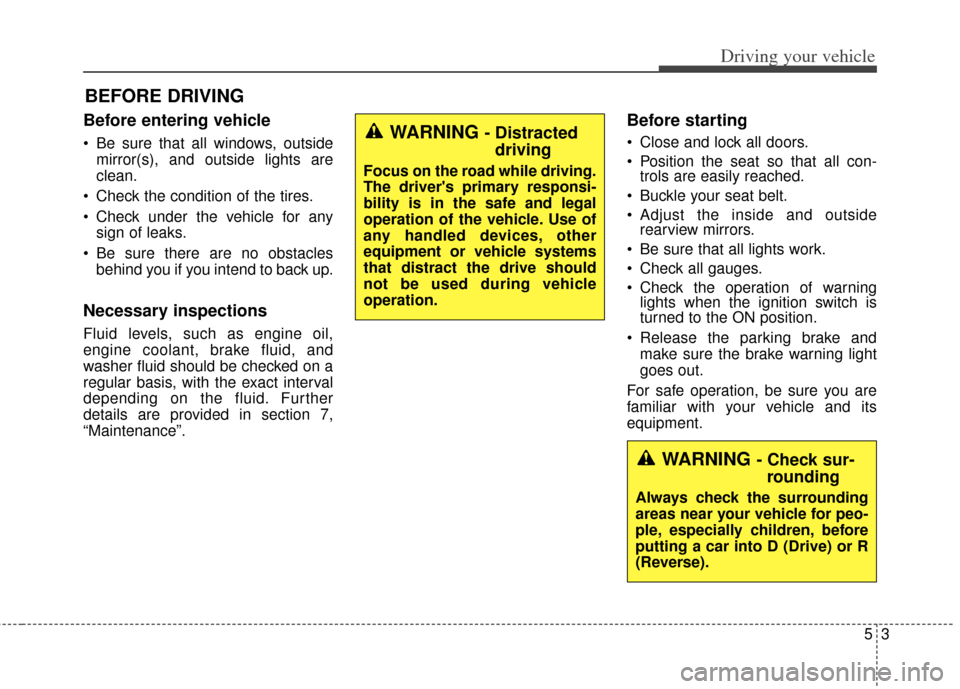
53
Driving your vehicle
Before entering vehicle
• Be sure that all windows, outsidemirror(s), and outside lights are
clean.
Check the condition of the tires.
Check under the vehicle for any sign of leaks.
Be sure there are no obstacles behind you if you intend to back up.
Necessary inspections
Fluid levels, such as engine oil,
engine coolant, brake fluid, and
washer fluid should be checked on a
regular basis, with the exact interval
depending on the fluid. Further
details are provided in section 7,
“Maintenance”.
Before starting
Close and lock all doors.
Position the seat so that all con-trols are easily reached.
Buckle your seat belt.
Adjust the inside and outside rearview mirrors.
Be sure that all lights work.
Check all gauges.
Check the operation of warning lights when the ignition switch is
turned to the ON position.
Release the parking brake and make sure the brake warning light
goes out.
For safe operation, be sure you are
familiar with your vehicle and its
equipment.
BEFORE DRIVING
WARNING - Distracted driving
Focus on the road while driving.
The driver's primary responsi-
bility is in the safe and legal
operation of the vehicle. Use of
any handled devices, other
equipment or vehicle systems
that distract the drive should
not be used during vehicle
operation.
WARNING - Check sur-rounding
Always check the surrounding
areas near your vehicle for peo-
ple, especially children, before
putting a car into D (Drive) or R
(Reverse).
Page 237 of 393
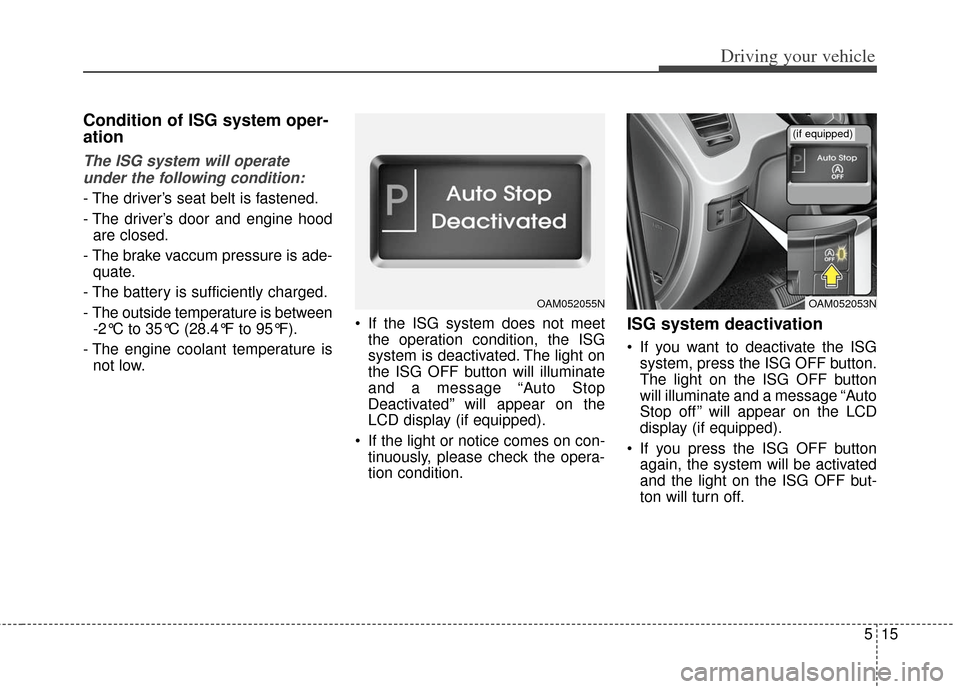
515
Driving your vehicle
Condition of ISG system oper-
ation
The ISG system will operateunder the following condition:
- The driver’s seat belt is fastened.
- The driver’s door and engine hood are closed.
- The brake vaccum pressure is ade- quate.
- The battery is sufficiently charged.
- The outside temperature is between -2°C to 35°C (28.4°F to 95°F).
- The engine coolant temperature is not low. If the ISG system does not meet
the operation condition, the ISG
system is deactivated. The light on
the ISG OFF button will illuminate
and a message “Auto Stop
Deactivated” will appear on the
LCD display (if equipped).
If the light or notice comes on con- tinuously, please check the opera-
tion condition.
ISG system deactivation
If you want to deactivate the ISGsystem, press the ISG OFF button.
The light on the ISG OFF button
will illuminate and a message “Auto
Stop off ” will appear on the LCD
display (if equipped).
If you press the ISG OFF button again, the system will be activated
and the light on the ISG OFF but-
ton will turn off.
OAM052055NOAM052053N
(if equipped)
Page 263 of 393
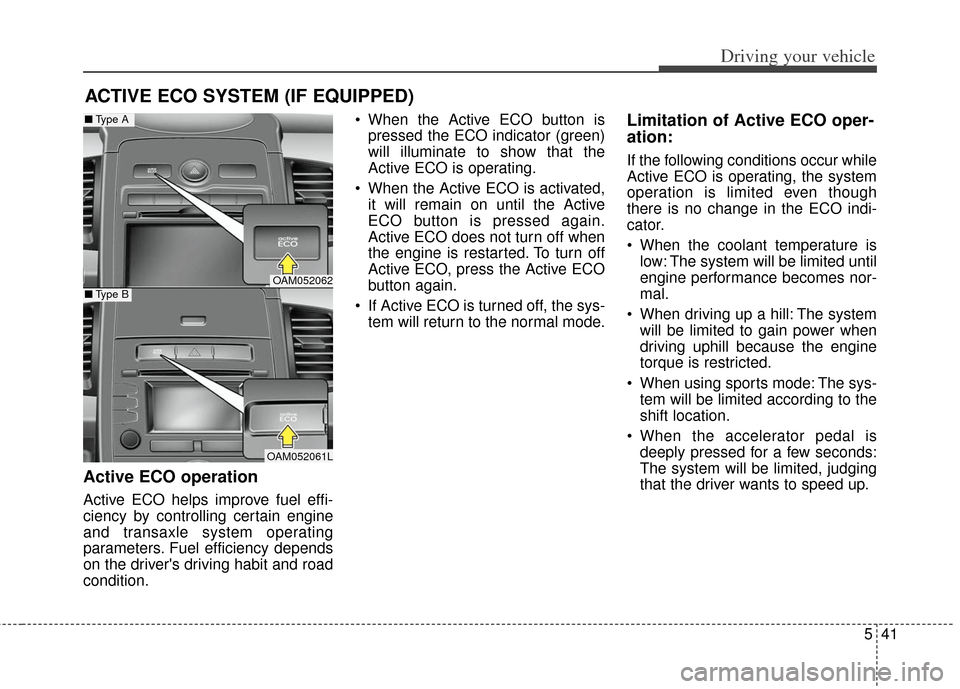
541
Driving your vehicle
Active ECO operation
Active ECO helps improve fuel effi-
ciency by controlling certain engine
and transaxle system operating
parameters. Fuel efficiency depends
on the driver's driving habit and road
condition. When the Active ECO button is
pressed the ECO indicator (green)
will illuminate to show that the
Active ECO is operating.
When the Active ECO is activated, it will remain on until the Active
ECO button is pressed again.
Active ECO does not turn off when
the engine is restarted. To turn off
Active ECO, press the Active ECO
button again.
If Active ECO is turned off, the sys- tem will return to the normal mode.
Limitation of Active ECO oper-
ation:
If the following conditions occur while
Active ECO is operating, the system
operation is limited even though
there is no change in the ECO indi-
cator.
When the coolant temperature islow: The system will be limited until
engine performance becomes nor-
mal.
When driving up a hill: The system will be limited to gain power when
driving uphill because the engine
torque is restricted.
When using sports mode: The sys- tem will be limited according to the
shift location.
When the accelerator pedal is deeply pressed for a few seconds:
The system will be limited, judging
that the driver wants to speed up.
ACTIVE ECO SYSTEM (IF EQUIPPED)
OAM052062
OAM052061L
■ Type A
■Type B
Page 270 of 393
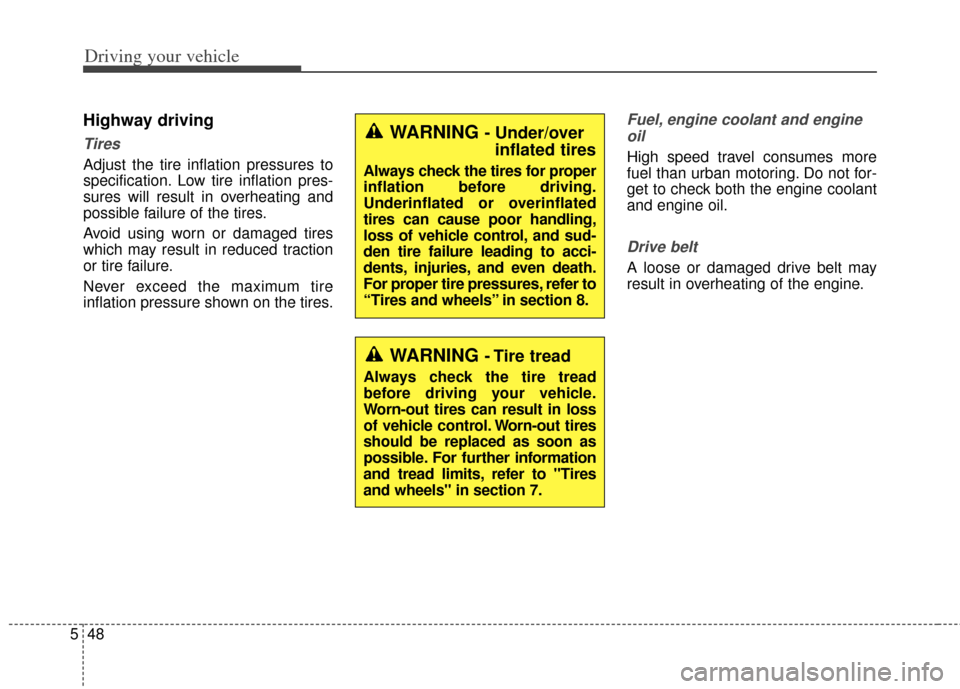
Driving your vehicle
48
5
Highway driving
Tires
Adjust the tire inflation pressures to
specification. Low tire inflation pres-
sures will result in overheating and
possible failure of the tires.
Avoid using worn or damaged tires
which may result in reduced traction
or tire failure.
Never exceed the maximum tire
inflation pressure shown on the tires.
Fuel, engine coolant and engine
oil
High speed travel consumes more
fuel than urban motoring. Do not for-
get to check both the engine coolant
and engine oil.
Drive belt
A loose or damaged drive belt may
result in overheating of the engine.
WARNING - Under/over inflated tires
Always check the tires for proper
inflation before driving.
Underinflated or overinflated
tires can cause poor handling,
loss of vehicle control, and sud-
den tire failure leading to acci-
dents, injuries, and even death.
For proper tire pressures, refer to
“Tires and wheels” in section 8.
WARNING - Tire tread
Always check the tire tread
before driving your vehicle.
Worn-out tires can result in loss
of vehicle control. Worn-out tires
should be replaced as soon as
possible. For further information
and tread limits, refer to "Tires
and wheels" in section 7.
Page 272 of 393

Driving your vehicle
50
5
Use high quality ethylene gly-
col coolant
Your vehicle is delivered with high
quality ethylene glycol coolant in the
cooling system. It is the only type of
coolant that should be used because
it helps prevent corrosion in the cool-
ing system, lubricates the water
pump and prevents freezing. Be sure
to replace or replenish your coolant
in accordance with the maintenance
schedule in section 7. Before winter,
have your coolant tested to assure
that its freezing point is sufficient for
the temperatures anticipated during
the winter.
Check battery and cables
Winter puts additional burdens on
the battery system. Visually inspect
the battery and cables as described
in section 7. The level of charge in
your battery can be checked by an
authorized Kia dealer or a service
station.
Change to "winter weight" oil
if necessary
In some climates it is recommended
that a lower viscosity "winter weight"
oil be used during cold weather. See
section 8 for recommendations. If
you aren't sure what weight oil you
should use, consult an authorized
Kia dealer.
Check spark plugs and igni-
tion system
Inspect your spark plugs as
described in section 7 and replace
them if necessary. Also check all
ignition wiring and components to be
sure they are not cracked, worn or
damaged in any way.
To keep locks from freezing
To keep the locks from freezing,
squirt an approved de-icer fluid or
glycerine into the key opening. If a
lock is covered with ice, squirt it with
an approved de-icing fluid to remove
the ice. If the lock is frozen internally,
you may be able to thaw it out by
using a heated key. Handle the heat-
ed key with care to avoid injury.
Use approved window washer
anti-freeze in system
To keep the water in the window
washer system from freezing, add an
approved window washer anti-freeze
solution in accordance with instruc-
tions on the container. Window wash-
er anti-freeze is available from an
authorized Kia dealer and most auto
parts outlets. Do not use engine
coolant or other types of anti-freeze
as these may damage the paint fin-
ish.
Don’t let your parking brake
freeze
Under some conditions your parking
brake can freeze in the engaged
position. This is most likely to hap-
pen when there is an accumulation
of snow or ice around or near the
rear brakes or if the brakes are wet.
If there is a risk the parking brake
may freeze, apply it only temporarily
while you put the gear shift lever in P
(Park, automatic transaxle) or in first
or reverse gear (manual transaxle)
and block the rear wheels so the
vehicle cannot roll. Then release the
parking brake.